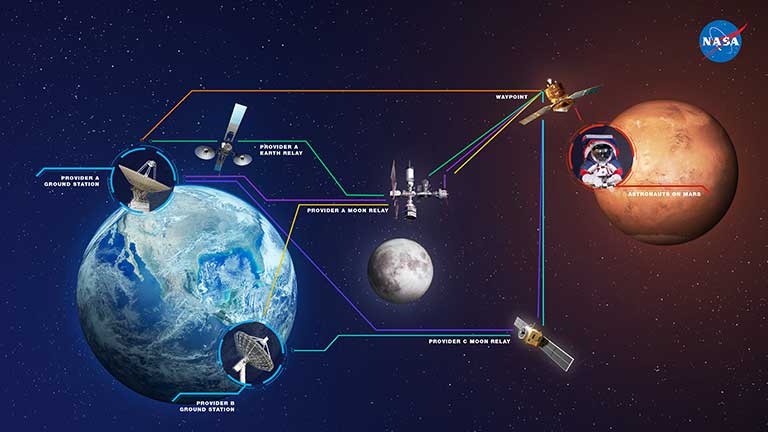Interplanetary Internet: Sending Data Across the Solar System
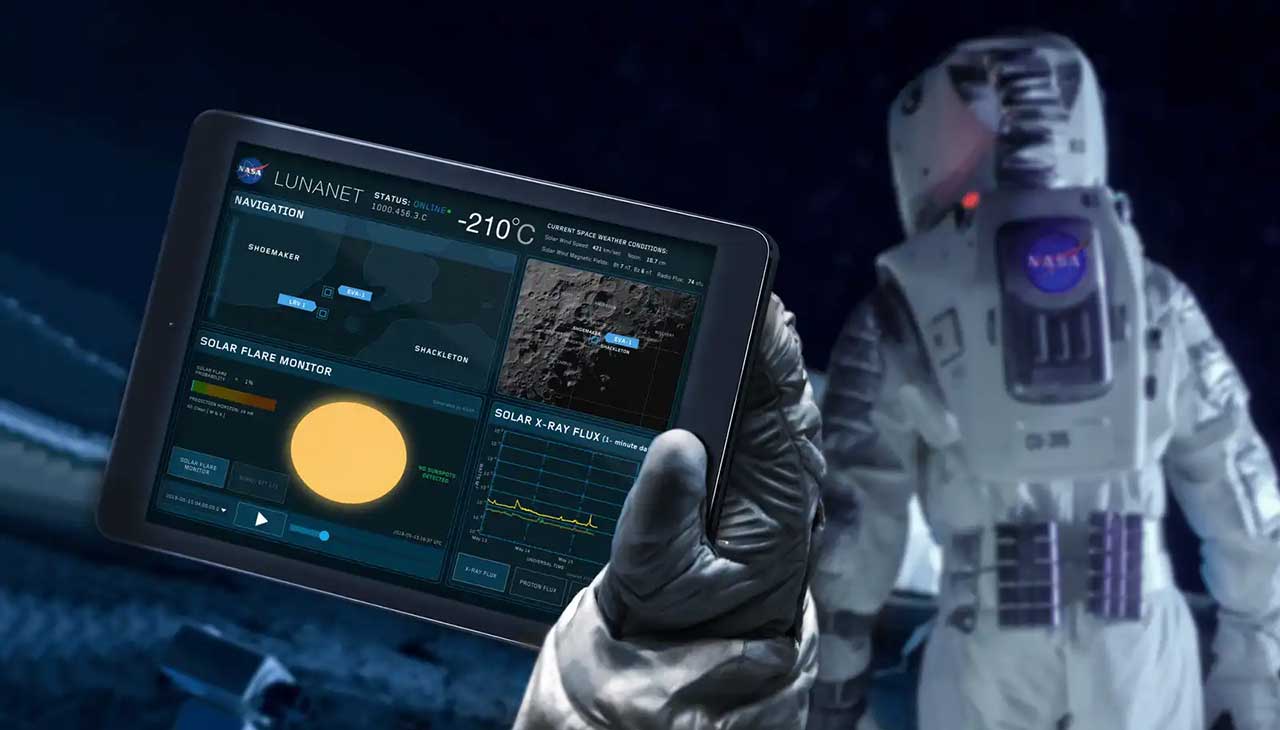
The future LunaNet will bring terrestrial Internet capabilities to astronauts, rovers, and orbiters.
Media Credit: NASA/Reese Patillo
July 23, 2025 • By Amelia Williamson Smith, Managing Editor
Imagine—your spacecraft lands at a future colony on Mars, and you’re eager to explore life on a new planet. You see the dusty red terrain stretching to the horizon. Olympus Mons, the tallest volcano in the solar system, rises in the distance. You want to share photos with your family and friends. But then you realize: there’s no Internet. You can’t communicate with others like you’re used to.
You arrive at your new home and need to look up some information and send an email to your coworker, so you pull out your laptop. Suddenly, it hits you. You can’t do that either. Frustrated, you decide to listen to some music, but then it dawns on you. There’s no online music library on Mars. You can’t watch your favorite TV shows and movies either.
You feel totally cut off and lost. Without the Internet, life as you know it is totally different.
As we look to a future where missions to other planets will not only be possible but commonplace, a key question looms: How will we communicate and transmit data? For nearly three decades, someone has been working on the solution—Vint Cerf, one of the two “fathers of the Internet” who co-developed the protocols that allow networks to connect.
It was the spring of 1998, and Cerf was excited by the success of the NASANational Aeronautics and Space Administration Mars Pathfinder mission and Sojourner, the first robotic rover to explore the Martian surface. As he envisioned a future where humans would one day set foot on the red planet, his mind shifted to an important question. “What should we be doing now that we’re going to need 25 years from now for space communications?”
Dressed in his signature three-piece suit in his office at Google headquarters, where he now serves as the company’s vice president and chief Internet evangelist, Cerf recalled a conversation he had with scientists at NASA’s Jet Propulsion Laboratory back in 1998. When he posed his question to the group, the answer became clear. “We needed to design an interplanetary backbone network to support human and robotic space exploration.”

Vint Cerf, one of the two "fathers of the Internet," co-developed the TCP/IP protocols.
Media Credit: The Royal Society
Such a network would connect people across the solar system. But there are challenges to creating an interplanetary Internet—the distances data must travel are much longer, and there’s not always a connection as planets and satellites move and block the signal. To address these issues, Cerf co-led the development of Delay and Disruption Tolerant Networking (DTN), in which the network stores “bundles” of data at intermediate nodes until a reliable path to the next node or the final destination becomes available.
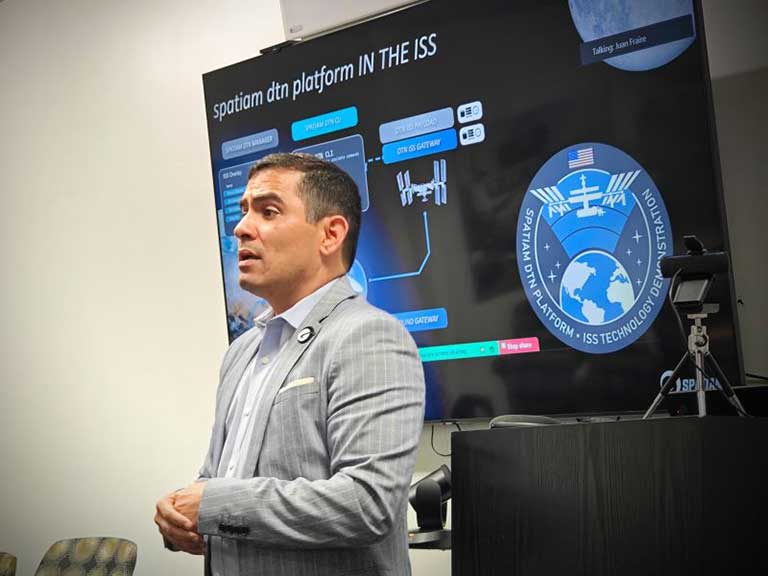
Alberto Montilla presented preliminary findings from Spatiam's ISSInternational Space Station technology demonstration at the 2024 Space-Terrestrial Internetworking Workshop in Mountain View, California.
Media Credit: Juan Fraire
Now, we are on the verge of the future Cerf envisioned. With plans for commercial space stations, sending astronauts back to the Moon, and human missions to Mars, the time has come to make interplanetary Internet a reality—and Spatiam Corporation is up for the challenge. The startup built a commercial platform for space communications based on DTN. However, to advance the technology, Spatiam needed to test it in the environment where it will operate: space. And to do that, the company turned to the International Space Station (ISS) National Laboratory.
“The most important thing for us as a company is being able to gain the operational experience to manage networks in space, and having access to that through the ISS National Lab was a fantastic opportunity,” said Spatiam CEO and co-founder Alberto Montilla. “The ISS was the ideal place to demonstrate our DTN platform for interplanetary networking because it provides a real-life operational scenario.”
Overcoming Connectivity Challenges in Space
The Internet connects billions of devices worldwide, putting global communication and data transfer at our fingertips 24/7. When data is sent through the Internet, it is broken into smaller units called packets. These packets travel through network devices like routers that determine the best path for each packet to take. Once the packets arrive at their destination, they are reassembled to recreate the original data.
When you think about the Internet on Earth, it has two key characteristics, Montilla explained. One is immediacy—given the relatively short distances data must travel between locations on Earth, the connection speed is incredibly fast. Delays are on the order of milliseconds, which is quicker than the blink of an eye. The other is ubiquity—anyone can connect to the network from anywhere in the world at any moment.
However, in space, things are radically different. Instead of immediacy and ubiquity, there is delay and disruption.
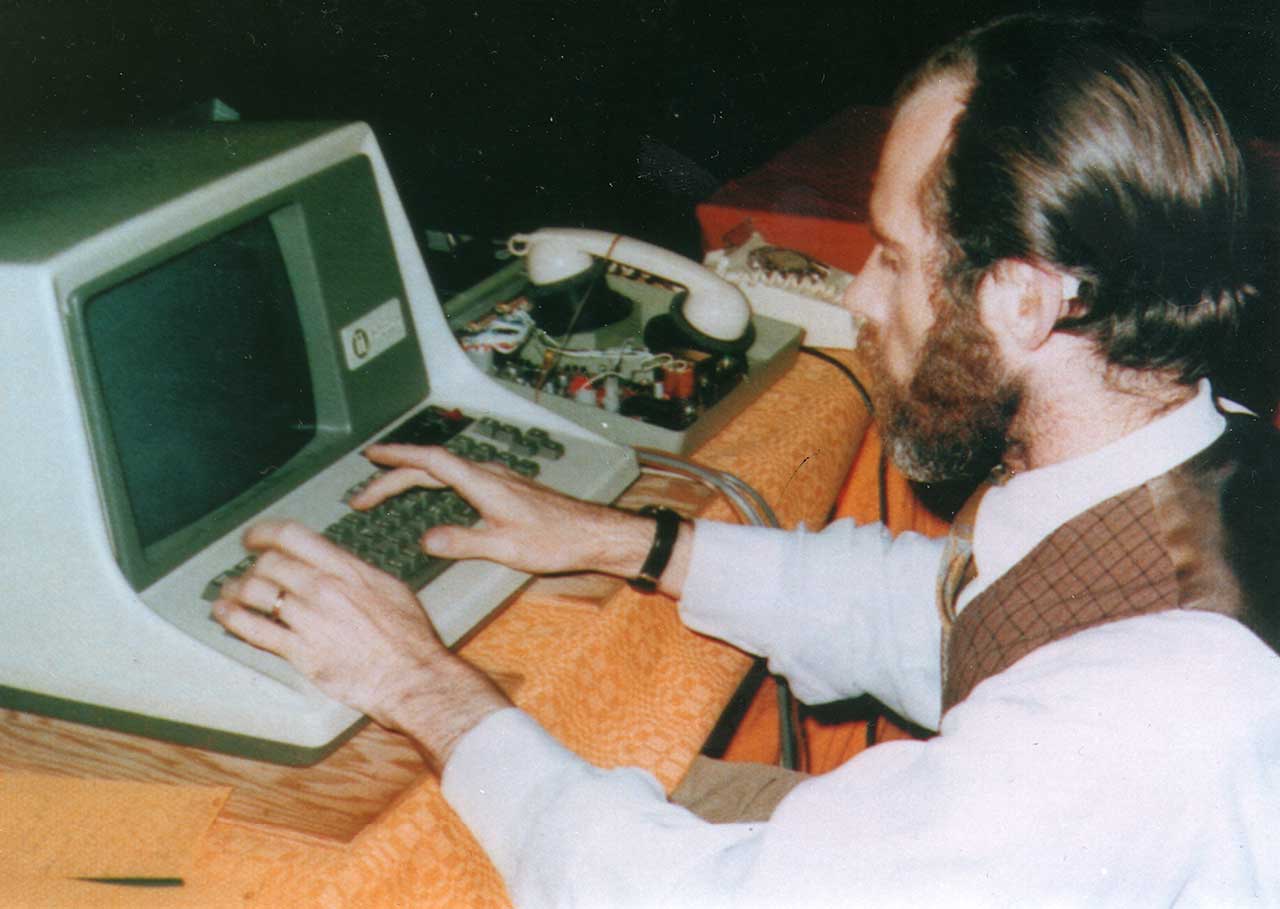
Vint Cerf is pictured here during an ARPANET demonstration in 1974.
Media Credit: Keith Uncapher, USC/ISI
“When you go to space, especially when you think about going to the Moon, signal delays—the time it takes for radio or light waves to move from one place to another—are in seconds, and when you go to Mars, it’s minutes,” Montilla explained.
Disruption is also a problem. When sending data from the Moon or Mars to a location on Earth, the two points do not always have a direct line of sight, leading to gaps in connectivity. Even on the ISS, communication is not continuous. Each day, there are several brief disruptions as the ISS orbits Earth and moves in and out of contact with ground stations and satellites.
“The TCP/IP protocols we created for the terrestrial Internet work well in a relatively low-latency, high-connectivity environment, but they’re not so attractive when you get to the deep space environment,” Cerf said. “So, we started working on new protocols, which we now call the Bundle Protocol Suite, for DTN.”
Enabling Reliable Communications
Currently, most data sent to and from space uses a direct link, which allows data to be sent from one entity to another when there is contact. The data moves from point A to point B—from the spacecraft to payload operations on the ground, for example. To transfer the data to a scientist at point C, a separate connection must be established.
It’s feasible to work around brief connectivity disruptions and manage contacts between one spacecraft, such as the ISS, and the operations team on the ground. However, managing contacts for a multitude of users sending data between Earth and commercial space stations or the Moon and Mars would be much more challenging, and a DTN platform will be vital.
“We’re moving from an entity that has been largely managed by a few space agencies to an entire ecosystem where there are going to be other government agencies along with a plethora of commercial companies of all types and sizes,” Montilla said.
By 2004, Cerf and his team had developed prototype software for DTN, and the first DTN operations on the ISS took place in 2009. Having reliable communications and navigation systems connecting space and Earth is crucial, said Philip Baldwin, assistant deputy associate administrator for the SCaN (Space Communications and Navigation) Program at NASA Headquarters in Washington.
“NASA uses DTN technology to safely store and forward data when a path opens,” Baldwin said. “Implementing these internetworking capabilities in space will decrease data loss, ensure data delivery, and provide mission teams with an ability to identify the location and timeline of data.”
From Nodes to Networks
Building on NASA’s extensive experience, Spatiam aims to develop the first commercial DTN platform for commercial space stations and operations on the Moon and Mars. Spatiam’s platform has three main elements: a DTN manager, DTN-managed instances (or nodes), and a DTN command line interface.
As its name suggests, the DTN manager directs the network, which is composed of several nodes. You can think of a network like a web, and each point where the web crosses is a node. You can transfer data from any point on the web to any other point by moving bundles of data from node to node until they reach the destination. The DTN manager configures the nodes to determine the best path for data to travel through the network. Through the DTN command line interface, users can send or request data without needing to know when contact occurs. Once the command is sent, the system holds the data and sends it during the next contact.

Alberto Montilla (back right) and Veronica Acosta (front right) meet with members of the Spatiam team.
Media Credit: Spatiam Corporation
In addition to delivering core DTN capabilities, Spatiam’s platform also provides advanced features that go beyond what’s currently possible on the ISS. One such feature supports a service provider architecture that uses bundle-in-bundle encapsulation, where a bundle of data is carried inside another bundle. This allows the inner bundle to be transmitted more securely and reliably through the network. Another feature is the ability to stream audio and video, allowing future astronauts to transmit ultra-high-definition video from the Moon’s surface to Earth, as is currently planned for NASA’s Artemis missions. The platform also allows multiple administrators to access the network and control nodes.
A Steppingstone to Commercialization
To test its DTN platform, Spatiam worked with ISS National Lab Commercial Service ProviderImplementation Partners that own and operate commercial facilities for the support of research on the ISS or are developing future facilities. Axiom Space, which provided the hardware for the investigation—an Amazon Snowcone edge computer on the space station. The Axiom team held weekly meetings with Spatiam to help navigate NASA requirements and daily meetings leading up to the ISS demonstration to resolve any issues.
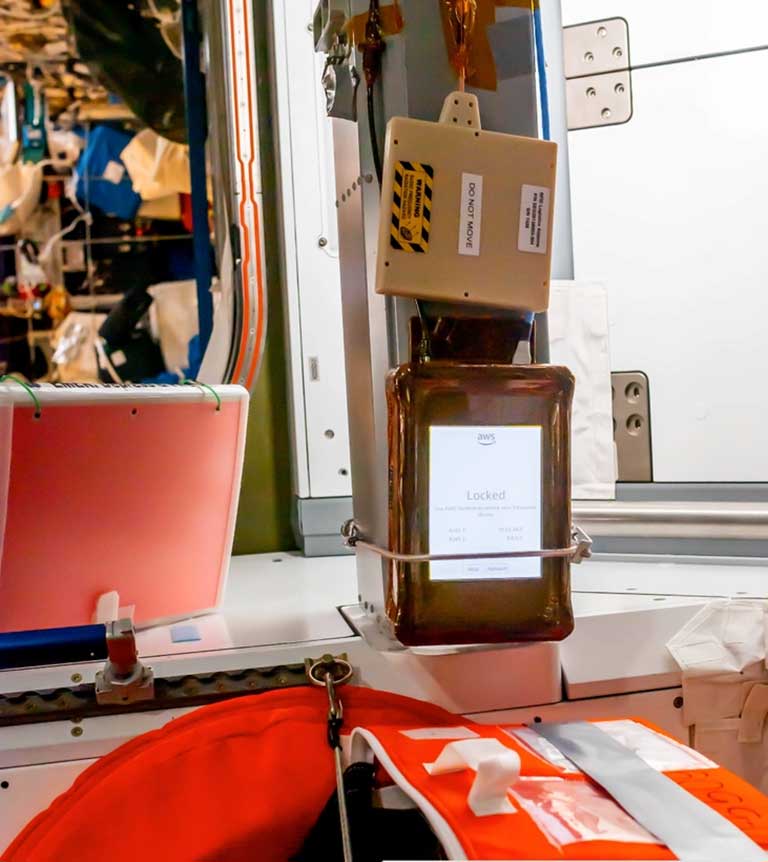
Amazon Snowcone onboard the ISS.
Media Credit: NASA
“This is important because it’s very different from the NASA network, which is administered by NASA alone,” Montilla said. “We wanted to demonstrate that we can create networks that have many different administrators, similar to the way the Internet is on Earth.”
Throughout the project, Spatiam ran more than 95 unique tests and successfully validated the core capabilities of its DTN platform, the performance of its DTN manager, and the platform’s advanced features. The team tested the DTN manager’s ability to set up an initial network of four nodes (two on the ISS and two on Earth), add new nodes, and change node configuration.
Using the DTN platform, the team successfully transferred multiple types of data to and from the ISS, including telemetry data, text commands and responses, text files, and binary files. The platform also successfully streamed audio and video. Bundle-in-bundle encapsulation—which had never been done in space before—was used during the entire 18-day demonstration.
With successful validation on the ISS, Spatiam raised the technology readiness level(Abbreviation: TRL) A measurement system used to assess the maturity level of a particular technology. There are nine technology readiness levels, and technology progresses from TRL 1 to TRL 9. (TRL) of its DTN platform to TRL 7, which is one step away from being flight-certified and ready for commercialization. Montilla stressed that access to the space station through the ISS National Lab was critical for advancing the company’s platform.
By supporting the development of new technologies like DTN, the U.S. government lays the foundation for successful commercialization. Cerf explained, “The Internet spread, in part, because the government made early investments and then the private sector said, ‘Oh, we can actually build and service and sell equipment and software to support the use of the Internet.’ Many of the applications of the terrestrial Internet have come from the private sector, driven not by government investment but by the government-created potential for private-sector investment.”
The Future of Networking in Space
Following Spatiam’s successful validation, the company received recognition across the industry. “This was an amazing opportunity to demonstrate our platform, and it has opened so many doors for us,” said Spatiam Business Development Manager Veronica Acosta. “We are very proud of these accomplishments and look forward to what’s next in advancing the space economy.”
Spatiam’s goal is to enable the DTN portion of the future LunaNet network on the Moon. LunaNet will serve both NASA and lunar commercial service providers, paving the way for networking on future missions to Mars. Although not part of the startup’s original plan, after working with the ISS National Lab, Spatiam realized there are also significant opportunities for DTN in the future LEO(Abbreviation: LEO) The orbit around the Earth that extends up to an altitude of 2,000 km (1,200 miles) from Earth’s surface. The International Space Station’s orbit is in LEO, at an altitude of approximately 250 miles. economy.
“As commercial space stations start to fly and NASA begins using commercial facilities in LEO, we have identified use cases where our DTN platform is valuable,” Montilla said. “So, our plan is to expand our platform to support not only missions to the Moon and Mars but also in LEO.”
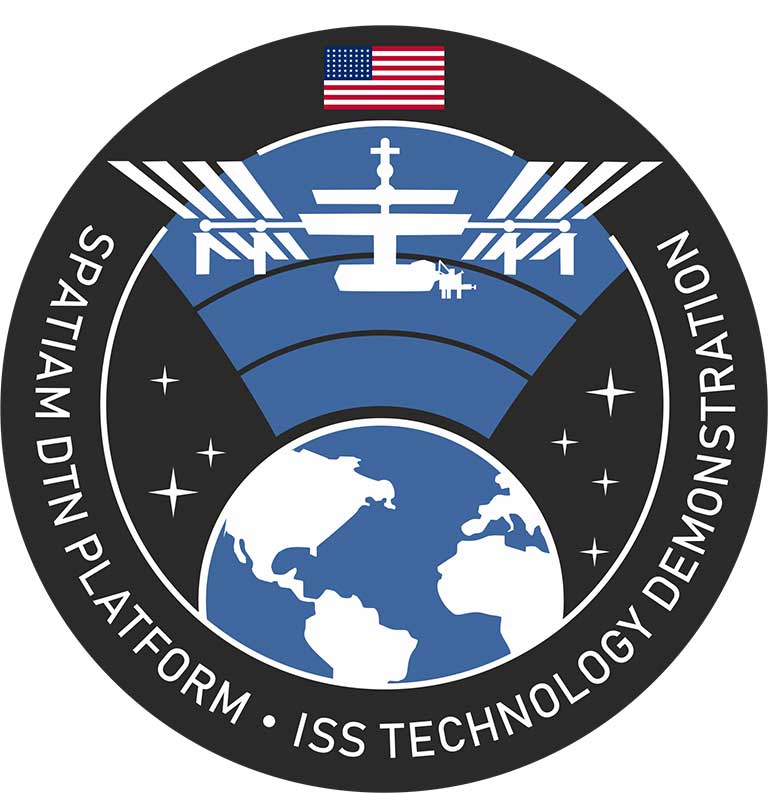
Patch for the Spatiam DTN technology demonstration on the ISS.
Media Credit: Spatiam Corporation
Looking to the future, the ability to communicate and transfer data will be crucial for exploration missions across our solar system. However, these capabilities will also be invaluable to the astronauts on those missions. Connection and communication are a central part of our humanity. With the help of DTN technology, astronauts on the Moon and Mars may be able to chat with family and friends back on Earth and send photos just as easily as we do today. And who knows—maybe one day, they’ll even be able to enjoy their favorite music, TV shows, and movies, too.
“I feel like I’m at the beginning of a much longer novel,” said Cerf, who is now in his 80s. “I won’t see the end of it, but I don’t regret that. I’m having too much fun being at the first few chapters and feeling like I have a front row seat for the evolution of a new capability that will one day serve humankind going off planet.”
